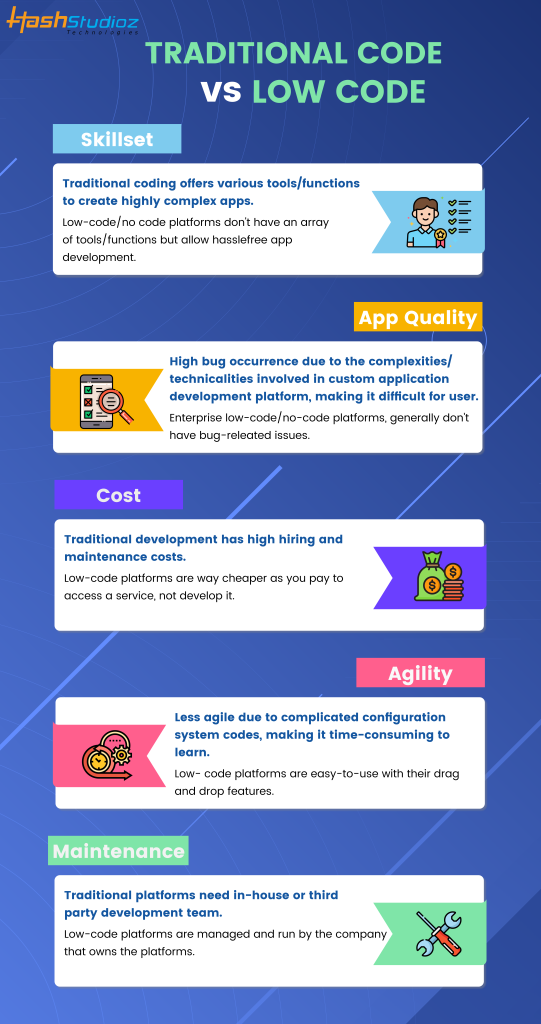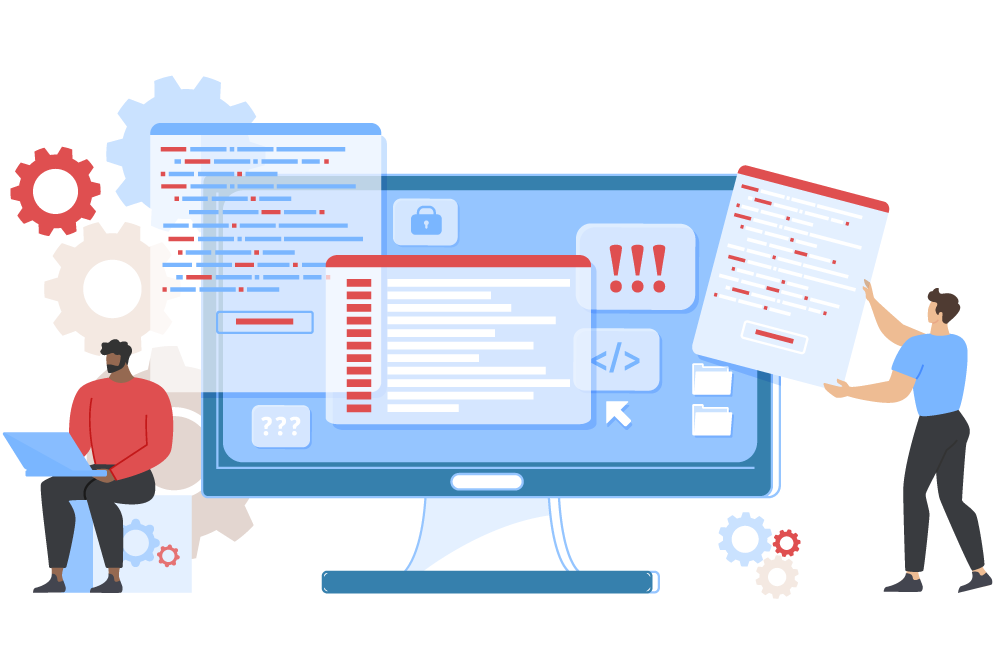Recommended Reasons On Picking Legacy application modernization with Low-code
Recommended Reasons On Picking Legacy application modernization with Low-code
Blog Article
Benefits Of Low-Code Application Development In Terms Of Accessibility For Non-Developers
Low-code apps improve accessibility for non-developers (often referred to "citizen-developers") because of a few key factors.
Drag-and -Drop Builders. Low-code platforms have drag-and-drop interfaces. This allows non-developers the ability to build applications visually, without writing code. This makes development easier for those who have little or no technical skills.
WYSIWYG Editors: "What You See Is What You Receive" editors allow users to build interfaces and workflows a manner that closely resembles the actual product, which makes it easier to understand and use.
Simplified logic and Workflow Design
Visual Workflow Modeling - Users are able to develop business procedures and logic applications using visual flowcharts and models. This is much more efficient than traditional programming techniques.
Pre-built Logic components: Low-code platforms include logic components that are already built (e.g. conditional statements and loops) and can be configured easily which eliminates the need for complex coding.
Reusable components and templates:
Library of Prebuilt Templates: Low-code platforms usually provide templates libraries for various types of application. This gives non-developers the ability to begin with a solid base and modify it as needed.
Reusable Widgets And Modules: Users are able to use the widgets that can be reused. This allows for a simpler creation and eliminates the requirement for deep understanding.
Guided development and tutorials:
Step-by -Step Instructions Platforms typically provide on-screen tutorials, guided development pathways, and other tools that help developers who are not developers create apps.
Interactive Tutorials Interactive and hands-on tutorials allow users to learn through doing. They can build confidence making use of the platform.
Integration with existing tools
Seamless Integration: Low-code platforms are designed to be easily integrated with existing tools for business and systems (e.g., CRM, ERP) which allows non-developers to create applications that work within their current workflows.
APIs and Connectors : APIs integrated into connectors and APIs enable users and non-developers to connect their applications to external services, without the need for complex coding.
Collaboration Features:
Team Collaboration: Real-time collaboration, shared workspaces, and shared workspaces permit business analysts, non-developers and other stakeholder groups to effectively collaborate with developers who are professionals.
Access Control Based On Roles: Users who do not develop can be assigned roles and access levels that allow users to contribute, without compromising security or functionality.
Automated testing and debugging:
Low-code platforms are often equipped with testing and debugging software that automates these processes. This makes it much easier for non developers to verify their applications function correctly.
Error Highlighting: Whenever problems occur the platform highlights any errors and suggests fixes, guiding non-developers through troubleshooting techniques.
The main benefit of developing applications using low-code for non-developers is in its ability to democratize the process of development. Low-code platforms enable business users to be involved in the creation and maintenance of applications through the use of intuitive visual tools as well as a guiding user experience. This is a bridge between the technical implementation and business requirements. Read the best Low-code Platform for application development tips for more tips including application development platforms, push alerts, app platforms, ms azure sql, azure sql, rapid applications, app modernisation, database in azure, app modernisation, rapid action development and more.
The Low-Cost Of Development Is One Of The Primary Benefits.
The low-code method of application development is a cost-effective solution that offers many advantages. It's an excellent choice for businesses looking to increase their budgets while delivering high-quality apps. The main benefits are: Reduced development costs
The low-code platform makes it less necessary to write long manual code. This means less time and effort on the part of developers while developing applications. This results in lower costs of labor.
We require less developer resources: Low-code development takes shorter time, and it is more simple. This means less developers are needed. This will reduce the costs of recruiting and retaining personnel.
Speedier Time To Market
Accelerated Cycle of Development Low-code platform visual tools and components allow for rapid development of applications. This allows companies to launch their new products quicker. This could result in faster revenue generation and improved standing in the market.
Rapid Prototyping. By rapidly creating and testing prototypes companies can reduce time spent on developing and develop faster on feedback from users.
Lower Maintenance Costs
Simplified Maintenance: Applications built using low-code platforms are generally easier to maintain due to their modular components and standard architecture. This reduces the cost of maintenance and ongoing support.
Automated Updates - A lot of low-code systems are capable of managing updates and patches in a manner that's safe and efficient. This eliminates the requirement to manually intervene.
Efficient Resource Utilization:
Contributions from Non-Developers: Low-code platforms enable business users and non-developers alike to take part in the process of development. This democratization allows businesses to use the skills of many employees, and lessen their dependency on highly-paid programmers.
Improved Utilization of IT Resources: IT departments are able to focus on more strategic initiatives rather than being bogged down with mundane development tasks which can increase overall productivity and efficiency.
The Scalable Pricing model
Subscription pricing: A lot of low-code platforms provide flexible pricing plans for subscriptions that can be scaled according to usage. This lets businesses align their spending with their actual needs and increase their revenue, without incurring large initial cost.
Pay-as-you-go options Certain platforms permit companies to pay for only the services they use. This is particularly useful for small or start-up businesses that have limited budgets.
Costs of Third-Party Software reduced:
Built-in Functionalities : A low-code platform typically comes with built-in functions and integrations which reduces the need for extra third-party tools, software and licenses.
Pre-Built Integrations: Having pre-built intiations with popular systems and services minimizes custom development. Time savings as well as money.
More ROI
Increased Return On Investment A combination of rapid development and lower costs, coupled with a faster time to marketing will allow businesses to earn greater return on investment.
Enhanced Agility - Businesses can quickly adapt to changes in market and changing customer needs. This helps them remain relevant and capitalize on opportunities that arise.
Lower Cost of Training
User-Friendly Interfaces: The intuitive interfaces and user-friendly features of low-code platforms reduce the learning curve thus making it less necessary to conduct intensive training.
Accessible Resources A lot of low-code platforms provide comprehensive training materials, tutorials as well as community support, reducing the need for formal training and associated cost.
Collaboration can be made more efficient.
Improved Collaboration Tool The integrated collaboration tool facilitates better collaboration and communication among team members. This results in more efficient development processes, and also reduces the cost of projects.
Unified Development Environment (UDE): A single, unified development environment simplifies processes and cuts costs and complexity associated with managing various tools and platforms.
Low-code development is cost-effective since it decreases maintenance and development expenses. It also reduces time to market and optimizes resource usage. Pricing models can be adapted. All of these factors provide significant financial benefits for businesses and make low-code development a viable option for companies looking to increase their budgets for development and create high-quality, flexible high-quality and robust applications. Follow the top rated Legacy application modernization with Low-code info for blog examples including multiplatform mobile app development, develop web application, rapid application design, app development platform, software for app development, azure sql server, develop web application, cross platform mobile app development, rad application development, app modernisation and more.
The Benefits Of Low-Code Programming For Community Members And Vendors
Low-code platform development provides significant advantages, including support from vendors and a community. This is crucial for ensuring the success of application implementation along with ongoing maintenance and continual improvement. Here are a few of the principal benefits: Support from the vendor
Comprehensive Technical Support:
Support Teams: Many Low-Code platforms provide access dedicated support team who can help with technical issues, help and troubleshooting.
Certain vendors offer support 24 hours a day. This can be very beneficial for businesses who operate across time zones.
Training and Onboarding
Vendors typically offer structured programs for users including tutorials or webinars. They might also offer certification courses.
A lot of vendors offer personalized onboarding that helps customers to make use of their platform effectively and customize it to meet the needs of their customers.
Regular updates and improvements:
Continuous Improvement Platform vendors typically regularly release updates that contain new features, performance improvements as well as security patches. This ensures that the platform is up-to-date and safe.
Feedback Integration: Vendors incorporate feedback from their users into their development cycles to ensure that the platform is constantly evolving to meet the ever-changing needs of its users.
Comprehensive Documentation:
Documentation is thorough users are able to access a wealth of well-organized documents, ranging in terms of complexity from basic customization to advanced.
API References Comprehensive API documentation allows developers to create custom applications and integrate low-code platforms with other systems.
Professional and Consulting Services
Expert Consulting : Vendors offer consultancy services, including the design of architectures and complicated implementations. They provide this service in order to make sure that their users can benefit from the platform.
Custom Development Services Certain vendors provide customized development services to create specific integrations and features that are not included in standard.
Community Support for the Community
Active User Communities
Forums and Discussion Boards A lot of low-code platforms offer vibrant online communities in which users can seek answers, discuss solutions, and work together on best practices.
User Groups and Meetups: Virtual and local user groups and meetups are great to meet, network and sharing your experiences with fellow users.
Collaboration and knowledge sharing:
Community-Contributed Resources: Users often share templates, modules, and extensions that they have developed, which can be reused or adapted by others, accelerating development and innovation.
Crowdsourced Solutions: The collective knowledge the experience, expertise and experiences of a community may be an effective tool for troubleshooting and finding creative solutions.
Learning and Development
Community-Led Learning: Several communities host training sessions, workshops and webinars that are often directed by experts who can provide insights and advanced techniques.
Online Tutorials and Courses Community members create and share tutorials, online courses and guides on how to use. This helps improve the learning tools that are available to users.
Feedback and Influence
Product Feedback Channels: Community forums usually include channels for providing feedback to the vendor that can affect the creation of new features or improvements.
Beta Testing Programmes: Community members who are active have the opportunity of participating in beta programs. It gives them the first glimpse of the latest features, as well as a chance to help shape the future of the platform.
Recognition and Support
Many vendors have communities recognition programs for example MVP programs (Most Valuable Professional) that recognize the efforts of their members who are active in their communities.
Peer Support : Members of the community offer support to other peers, sharing their experience and providing guidance. They help create a cooperative and supportive environment by sharing their knowledge.
Overall, the combination of a solid vendor's support as well as an active, vibrant community provides a complete assistance system for low-code application development. Users will be able get the help, resources, and collaboration opportunities they need in order to successfully build, deploy, maintain and improve their applications.